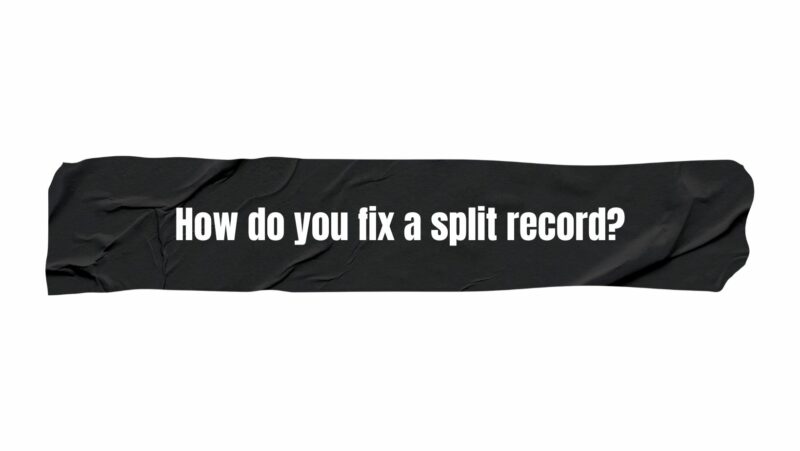For vinyl enthusiasts, a split record can be a disheartening sight. The crack that appears on a cherished vinyl record not only mars its visual appeal but also threatens to disrupt the listening experience. However, all is not lost when faced with a split record. This article delves into the intricate process of fixing a split record, offering insights into various techniques and considerations that can help restore the integrity of these musical treasures.
Understanding the Split:
A split in a vinyl record occurs when the delicate vinyl material cracks or separates due to factors like mishandling, temperature changes, or age-related wear. The split can range from a hairline crack to a more significant fracture that affects the grooves containing the audio information. Addressing this issue requires a careful approach to ensure the record’s visual and auditory qualities are preserved.
Assessment and Materials:
Before attempting any repair, it’s essential to assess the extent of the damage. Examine the split to determine its length, depth, and impact on the grooves. Additionally, gather the necessary materials for the repair process:
- Superglue or Vinyl-Specific Adhesive: Opt for a high-quality adhesive that is compatible with vinyl material to ensure a secure and long-lasting repair.
- Tape: Transparent tape or painter’s tape can be used to hold the split edges together during the repair process.
- Precision Tools: Fine-tip applicators, toothpicks, or small brushes will aid in applying adhesive accurately.
- Microfiber Cloth: Use a lint-free microfiber cloth for cleaning the record before and after repair.
Step-by-Step Repair Process:
- Clean the Record: Begin by cleaning the record’s surface gently using a microfiber cloth to remove any dust, dirt, or debris. A clean surface ensures a more effective repair.
- Align the Split: Carefully align the split edges of the record, ensuring they match as closely as possible. Use transparent tape or painter’s tape to hold the edges in place.
- Application of Adhesive: Apply a small amount of vinyl-specific adhesive or superglue along the split, making sure not to use excessive adhesive that could seep into the grooves. A fine-tip applicator or toothpick can help control the application.
- Press and Hold: Gently press the split edges together, holding them in place for the duration recommended by the adhesive manufacturer. This step is crucial to ensure a strong bond forms.
- Curing Time: Allow the adhesive to cure for the recommended duration. Avoid moving or touching the record during this time to prevent disrupting the repair process.
- Cleanup: Once the adhesive has cured, carefully remove the tape used to hold the split edges together. Clean any excess adhesive using a microfiber cloth and a mild cleaning solution if necessary.
- Testing Playback: Before playing the record, ensure the repaired area is not interfering with the stylus or causing skips. Test playback on a less valuable turntable first to ensure there are no issues.
Considerations and Limitations:
While fixing a split record is possible using the above steps, it’s essential to keep in mind several considerations and limitations:
- Sound Quality: Depending on the accuracy of the repair and the quality of the adhesive used, there might be a slight impact on sound quality in the repaired area. Audiophiles may notice subtle changes in playback.
- Visible Repair: The repaired area may remain slightly visible, even with meticulous application. This could affect the record’s aesthetic appeal, particularly for collectors concerned about visual integrity.
- Future Deterioration: A repaired split might still be susceptible to future wear or deterioration, especially if the original vinyl material is weak or brittle.
When to Seek Professional Help:
While the DIY approach can yield successful results, certain scenarios warrant professional intervention:
- Valuable Records: For valuable or rare records, it’s advisable to consult professional record restoration experts to ensure the repair is carried out skillfully.
- Complex Repairs: Extensive fractures or splits that affect multiple grooves or involve intricate patterns may require specialized expertise for a seamless repair.
Conclusion:
Repairing a split record requires a delicate touch, careful alignment, and the right adhesive. While the DIY approach is possible and can yield satisfactory results, it’s important to consider the potential impact on sound quality and visual aesthetics. Vinyl enthusiasts should weigh the importance of the record against the potential risks and decide whether to embark on a repair journey or seek professional assistance. Ultimately, the goal is to preserve the integrity of the music and maintain the allure of vinyl records for generations to come.


